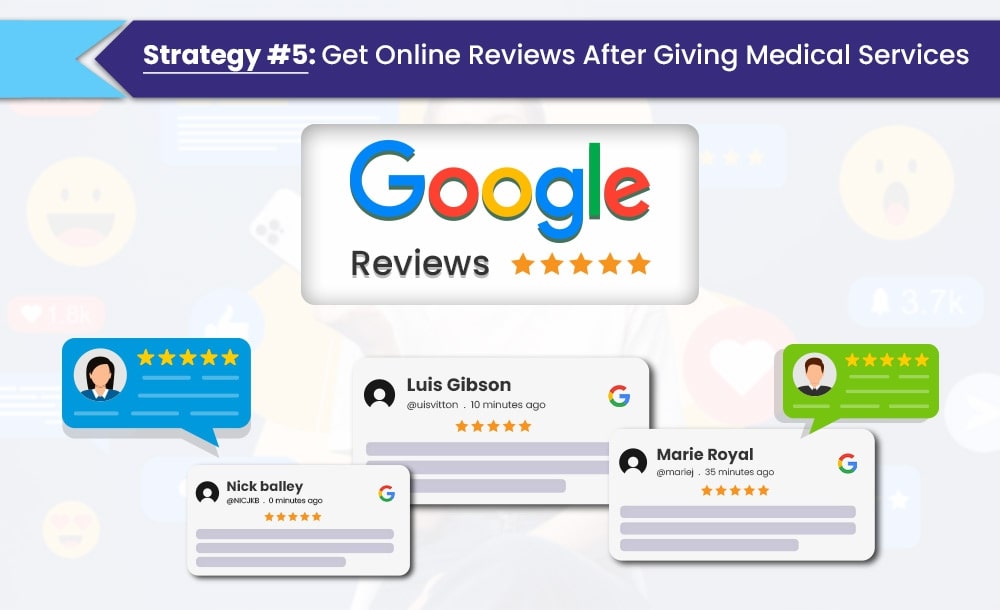Owning and running a small medical practice smoothly is no small feat. Maintaining a balance between providing quality patient care and attracting new patients can often feel overwhelming.
Small practices, in particular, face challenges in standing out within a crowded healthcare market.
So the key question is: how can you grow your small medical practice while tackling these challenges? What marketing strategies are most effective for achieving sustainable growth?
In this blog, we’ll explore some of the common challenges small medical practices face, along with top marketing strategies to help your small practice thrive.
Challenges in Small Medical Practice Marketing
We’ve highlighted some of the challenges that can help you understand the unique needs of your healthcare practice as a small medical practice owner. Recognizing these challenges is the first step toward developing effective marketing strategies that specifically address the demands of small medical practices.

😫 Managing a Low Marketing Budget
Small healthcare practices often grapple with limited marketing budgets, which can hinder their ability to compete with larger healthcare organizations. According to a recent survey, 62% of healthcare practices spend only 1-5% of their total revenue on marketing. This limited budget can make it difficult to invest in effective marketing strategies. However, relying solely on word-of-mouth may not be enough to gain visibility in the highly competitive healthcare industry.

╰┈➤ Get Marketing Strategies Within Budget
😫 Implementing Marketing Strategies Within Budget
It’s essential for small medical practices to identify marketing strategies that align with their limited budget. Leveraging cost-effective digital marketing methods, such as social media, search engine optimization (SEO), and local partnerships, can help maximize the impact of your marketing efforts without breaking the bank.
😫 Maintaining HIPAA Compliance
Maintaining HIPAA compliance is a significant challenge for small medical practices. It’s crucial to ensure that all marketing strategies comply with HIPAA regulations, which involve stringent monitoring and staying up to date with evolving policies. A study by the AMA indicates that small practices often struggle to maintain these policies, which could lead to financial and legal repercussions in the event of a violation.
😫 Overcoming the Lack of Marketing Expertise
Many small medical practices lack dedicated marketing professionals on their teams. This gap can result in challenges when it comes to developing and implementing effective marketing strategies. Without the right expertise, small practices may implement inappropriate marketing tactics, miss opportunities, and fail to engage patients optimally.
😫 Targeting the Right Audience
Targeting the right audience is key to attracting more patients. However, many small practices fail to effectively target their ideal patient demographic. Incorrect targeting can result in wasted marketing efforts and poor return on investment. For example, a small practice offering pediatric services in California would not benefit from targeting senior citizens.
😫 Building and Maintaining Trust
Trust is essential in the healthcare industry, and small practices can struggle to build it due to limited time and resources. A lack of clear and honest communication about treatment options and costs can lead to a lack of transparency. Maintaining trust with patients is a long-term effort that requires open, transparent communication. According to a survey, approximately 81% of patients trust their doctors—a trust that can be cultivated through positive experiences and transparent interactions.

10 Best Marketing Strategies for Small Medical Practice

The challenges mentioned above are significant, but not impossible to overcome. Small medical practices can break through these barriers with smart and creative healthcare marketing strategies. By implementing these strategies, your small practice can be positioned for consistent, long-term success. Let’s explore some smart marketing strategies to help grow your small medical practice.
1). Start with Building a Website

A well-designed website is the cornerstone of your online presence and one of the best business development strategies for small medical practices. Your website is often the first point of contact for potential patients, so it’s essential to make a strong first impression.
As Jay Samit wisely said,
“Design is how you make your first impression with your consumer. Make sure it is a lasting one.”
Ensure your website is mobile-friendly, easy to navigate, and visually appealing. Studies show that 53% of mobile users will abandon a site if it takes longer than 3 seconds to load.

With this in mind, a responsive and fast website is crucial for retaining patient interest. Include vital information such as services, contact details, operating hours, and an online booking system to streamline patient interactions.
Also, ensure your website complies with HIPAA regulations, especially if you collect Patient Health Information (PHI). Securing your site with an SSL certificate is vital for protecting patient data and ensuring a safe browsing experience.
BellMedEx can help you create a professional, user-friendly website that attracts more patients and supports the growth of your practice.
2). Optimize Your Google Business Profile (GBP)

Optimizing your Google Business Profile (GBP) is an essential part of any ideal marketing method for small medical practices. GBP enhances your visibility in local search results and helps patients find your practice easily. Start by claiming and verifying your GBP listing, ensuring that all your details—such as address, phone number, and business hours—are accurate.
Incorrect information can lead to frustration for patients. Nearly 93% of consumers are annoyed by inaccurate details in online directories, and 80% of patients lose trust in practices with wrong contact information. Therefore, keeping your GBP listing updated is crucial.

Enhance your GBP by adding high-quality photos, showcasing your practice and team, and regularly updating it with posts, promotions, and patient tips. Selecting the right categories and attributes for your practice, such as telehealth or wheelchair accessibility, will help you stand out in local search results and attract more patients.
3). Invest in Healthcare SEO

Investing in SEO (Search Engine Optimization) is an essential marketing approach for small medical offices looking to increase their online visibility. A strong SEO strategy ensures your website appears at the top of search results when potential patients search for your services. Start by optimizing your website’s content with targeted keywords relevant to your practice’s services and location.
For instance, if you’re a pediatrician in Lubbock, you might use keywords like “pediatrician in Lubbock, TX” or “best pediatrician in Lubbock.” This increases the likelihood that your practice will show up when people search for these terms.

Additionally, technical SEO is essential for improving site speed, making the website mobile-friendly, and ensuring a clean URL structure. By using tools like Google Search Console, you can identify and fix any technical issues that may impact your site’s performance.
BellMedEx’s healthcare SEO experts specialize in improving search engine rankings and driving organic traffic to help your small practice get noticed by more patients.
Off-page SEO is equally important as On-Page SEO. You can build high-quality backlinks from reputable websites, local businesses, and directories that can make much of a difference in your search engine rankings. Keep an eye on both on-page and off-page SEO efforts by using different tools like SEMrush or Ahrefs to track your progress and adjust your marketing strategies as needed.

Always remember that 3 out of 4 (75%) of consumers never go beyond the first page of search results, so it’s important to ensure a website ranks high through SEO.
4). Use Social Media for Reputation Building

Social media is among the most effective tools for building your practice’s reputation and engaging with potential patients. It’s also an integral part of the ideal promotional strategy for small health practices. Platforms like Facebook, Instagram, LinkedIn, and Twitter allow you to share helpful content, engage with patients, and showcase your services in a more personal way.
With over 300 million social media users in the U.S. by 2024, it’s essential to create a professional social media presence to reach this growing audience.
Here’s a breakdown of the number of social media users in the United States from 2020 to 2029.
- 2020: 268.54 million
- 2021: 278.79 million
- 2022: 286.71 million
- 2023: 294.12 million
- 2024: 300.86 million
- 2025: 307.06 million
- 2026: 312.74 million
- 2027: 317.99 million
- 2028: 322.84 million
- 2029: 326.75 million

This progression speaks loudly about increasing trends in social media usage.
You have to take a step forward by creating a professional profile for your small medical practice on major social media platforms. Encourage your patients to follow your healthcare practice’s social media platforms.
Plus, you must stay active on all social platforms like Facebook, LinkedIn, and Instagram to build interactive relationships with your audience. By responding quickly to messages and comments, you create a sense of care and responsiveness that patients value.
5). Get Online Reviews After Providing Services

Online reviews are incredibly important in the healthcare industry, and implementing a system to collect and respond to reviews should be a priority in your practice’s marketing and patient acquisition strategies.
According to Bright Local, 76% of consumers read reviews regularly when selecting local services, making online reviews one of the innovative marketing ideas for small healthcare providers to enhance credibility.

Encourage satisfied patients to leave reviews on platforms like Google, Yelp, and Healthgrades. Provide easy access by sending follow-up emails or text messages with direct links to your review pages. Respond to all reviews—positive or negative—in a professional and empathetic manner. Address negative feedback by acknowledging concerns and offering solutions to show your commitment to patient satisfaction.
6). Publish Relevant Content Regularly

Content marketing is one of the proven marketing approaches to build trust and visibility online. Regularly publishing relevant, high-quality content on your website is a powerful tool for positioning your practice as a trusted healthcare authority. Content marketing is a highly effective way to market small healthcare services because it not only enhances your SEO but also helps keep your practice active in the minds of patients.
Start by publishing informative blogs, videos, and infographics related to common patient concerns or trending medical topics. This helps in engaging your audience while improving your search engine rankings. In fact, businesses with blogs get 97% more links to their website, which boosts visibility and SEO. Share your content on social media and through email newsletters to reach a broader audience.
By continuously updating and sharing useful content, you ensure your practice remains a valuable resource for current and potential patients, which enhances both patient trust and engagement.
7). Offer Discounts and Free Coupons for Services

Offering promotions or discounts can be a standout among the most successful marketing plans for small medical facilities looking to increase patient volume. Special offers, such as discounted initial consultations, free health screenings, or referral incentives, can help draw new patients to your practice, giving you a competitive advantage in your area.
Research indicates that 80% of consumers are more likely to choose a service if it includes promotions. Therefore, including these offers in your publicity strategy is a smart move to boost patient interest and attract more visitors to your practice.

Promote these discounts through your website, social media channels, and email newsletters to maximize visibility. Ensure the terms and conditions are clear, easy to understand, and allow for simple redemption.
Regularly assessing the ROI of your promotions will help refine your strategy and ensure you’re offering incentives that resonate with your target audience.
8). Collaborate with Other Physicians for Referral Marketing

Referral marketing is another one of the best strategies for small medical practices to expand their patient base. By collaborating with other healthcare providers, such as general practitioners, specialists, or local clinics, you can create a mutually beneficial referral network. This is an ideal marketing method for small practices to leverage relationships and drive new patient volume.
Attending medical conferences, joining local professional associations, or hosting community health events can be great ways to connect with other healthcare providers. Once relationships are established, referrals will naturally flow between practices, ensuring a steady stream of new patients.
When you first begin collaborating with other physicians, both parties are often excited about the potential to reach more patients and provide better care. The conversation might go something like this:
Physician 1: “Do you think our collaboration will benefit our patients?”
Physician 2: “Absolutely! I’m confident it will.”
Physician 1: “Great! Who else in your network could benefit from referring patients to our practice?”
This direct approach is a good way to kickstart referral marketing. It not only creates a steady flow of patient referrals but also improves care coordination between healthcare providers.
Remember, a trusted network is key to sustaining long-term growth for your practice.
9). Maintain Regular Outreach Efforts

One of the top marketing solutions for small healthcare practices is maintaining regular communication with your patient base. Through consistent outreach, such as email newsletters, social media posts, and community events, you keep your practice at the forefront of your patients’ minds. This ongoing engagement fosters loyalty and trust, making it easier to retain existing patients and attract new ones.
Automating email campaigns, integrating appointment reminders, and utilizing social media scheduling tools can streamline your outreach efforts. This also allows for timely and personalized communication, making it easier for patients to engage with your practice and book appointments.
Regular outreach also demonstrates your commitment to patient care, which is crucial for improving both retention and new patient acquisition. By staying active in the community and digitally, you’ll solidify your practice as a top choice in your area.
10). Add E-Commerce Solutions for Self-Pay Patients

Implementing e-commerce solutions for self-pay patients is an often-overlooked but powerful marketing tactic for small medical practices. Allowing patients to pay for services online adds convenience and security, which enhances patient satisfaction—a critical factor in retaining patients. This is one of the best strategies for small medical practices to improve operational efficiency while providing a better patient experience.
In fact, 73% of consumers prefer paying their medical bills online. Offering online payment options for appointments and telehealth services makes the process seamless and eliminates barriers to care. Adding an e-commerce solution can also reduce administrative burdens by automating billing and payment processing, which helps improve cash flow.

Additionally, introducing subscription-based services for self-pay patients provides more predictability in healthcare costs, benefiting both the patient and your practice. Offering these types of flexible solutions is an effective way to make your services more accessible and appealing to patients seeking more control over their healthcare finances.
Conclusion
Adopting the right marketing strategies can help your small medical practice stand out in the competitive healthcare industry. These strategies not only address the challenges faced by smaller practices, but they also enable you to compete more effectively with larger healthcare organizations. By implementing them, you can build a loyal patient base, earn trust, and create a sustainable path to long-term success.
So, take action today and apply these strategies to give your small medical practice the recognition and value it deserves.








